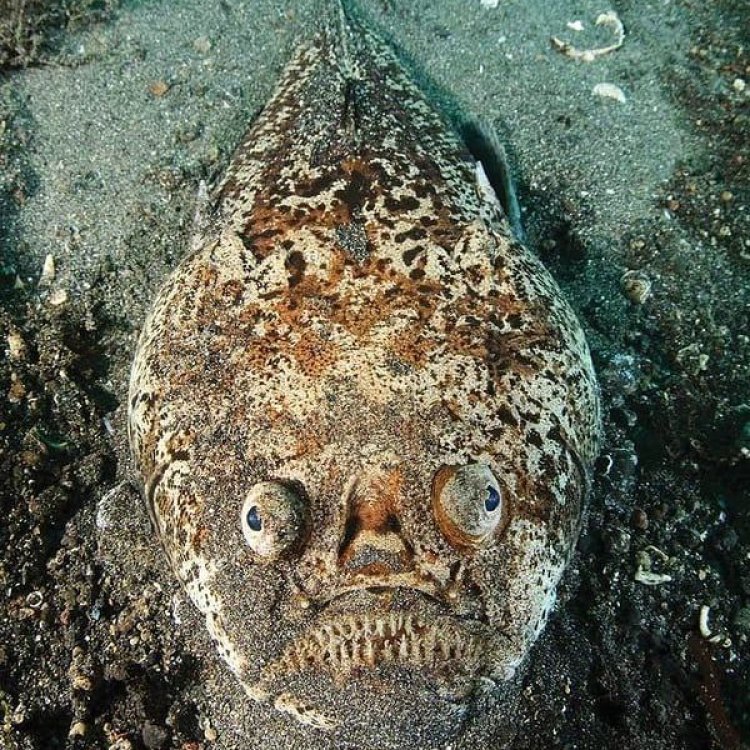
Stargazer Fish
Up to 18 inches
The Stargazer fish, also known as the Uranoscopidae, can grow up to 18 inches and has a unique body shape - flat and laterally compressed. This fish species can be found in coastal areas and is often admired for its striking appearance. Have you ever seen a stargazer fish in person?
Animal Details Summary:
Common Name: Stargazer Fish
Kingdom: Animalia
Habitat: Marine
The Mysterious World of the Stargazer Fish: Masters of Camouflage and Ambush Predation
Deep in the dark depths of the world's oceans, there lives a mysterious and elusive creature known as the Stargazer Fish. This intriguing species, with its unique appearance and fascinating behaviors, has captured the imagination of humans for centuries. And it's not hard to see why – with its ability to blend into its surroundings, it truly is a master of camouflage, earning its rightful place as one of nature's most skilled predators.A Fish Like No Other
Scientifically known as Uranoscopus spp Stargazer Fish., the Stargazer Fish is also commonly referred to as the "Stargazer" due to its upward-facing eyes. This distinctive feature, coupled with its flat and laterally compressed body shape, gives the fish an otherworldly appearance, almost like it's staring back at you from another dimension.The Stargazer belongs to the kingdom Animalia, phylum Chordata, and class Actinopterygii, meaning it is a vertebrate with fins as its main form of movement. It is a member of the Perciformes order and the Uranoscopidae family, making it a distant relative of the popular and colorful angelfish and butterflyfish.
A Stealthy Predator
One of the most intriguing aspects of the Stargazer Fish is its feeding method – it is an ambush predator. This means that it hides and waits for unsuspecting prey to come within reach before quickly striking and devouring its meal. This strategy requires exceptional camouflage, and the Stargazer has evolved to be a master of this art.Found in various oceans worldwide, in coastal areas and on sandy bottoms, the Stargazer relies on blending in with its surroundings to catch its prey. With its unique coloration, which varies from individual to individual, it can easily disappear into its environment, lying in wait for unsuspecting fish and crustaceans to swim by Sinosauropteryx.
Tricks and Traps
The Stargazer Fish doesn't just rely on its physical appearance for ambush hunting; it also has some tricks up its sleeve. The fish has a mouth lined with sharp, needle-like teeth, and as it lies buried in the sand, only its mouth and eyes are visible. When an unsuspecting prey comes too close, the Stargazer can quickly shoot out its mouth, leaving its prey no chance to escape.Another interesting and unique feature of the Stargazer is its ability to produce an electric shock. It has special organs near its eyes that can generate up to 50 volts of electricity, which it uses to immobilize its prey or deter predators.
A Global Presence
While the Stargazer Fish is a well-known species, very little is known about their exact distribution and population numbers due to their elusive nature. They are found in various oceans worldwide, and different species are found in different regions, including the Atlantic, Pacific, and Indian oceans.While the exact country of origin for the Stargazer is unknown, it is believed to have originated from various locations depending on the species. Some are believed to have come from coastal areas in Asia, while others may have originated from the Mediterranean or the coast of Portugal.
A Unique Habitat
As mentioned earlier, Stargazers are found in coastal areas on sandy bottoms. However, they are also known to inhabit rocky or muddy areas and can even be found in shallow waters, including tide pools. Due to their ambush hunting style, they prefer to stay hidden, which is why they often bury themselves in the sand or camouflage themselves with rocks and seaweed.Another interesting fact about the habitat of Stargazer Fish is their preference for living in silty or muddy areas. This is because the fish is able to sense the vibrations of their prey and easily detect movement in these soft substrates, giving them an edge in their ambush hunting strategies.
Mind-Blowing Camouflage
The Stargazer Fish has a unique and mesmerizing ability to change its color and adapt to its surroundings. This is possible due to specialized cells called chromatophores in its skin that expand and contract, allowing the fish to mimic the color and pattern of its environment. This impressive camouflage ability makes the Stargazer nearly invisible, making it a true master of disguise.A Feast for the Eyes
Aside from its ability to blend into the background, the Stargazer Fish also has some stunning natural beauty of its own. Its scales have a velvety texture, and it comes in a variety of colors ranging from gray and brown to black and even blue. Some species even have striking patterns on their body, making them a feast for the eyes.But don't be fooled by its mesmerizing appearance – the Stargazer is a formidable predator and one of the top predators in its ecosystem.
A Lifespan of Mystery
Unfortunately, due to the elusive nature of the Stargazer Fish, the average lifespan of this species is still a mystery. Some species of Stargazers have been found to live up to 18 years, while others have been observed to survive for only 6 years. Due to their unique and secretive lifestyle, it is challenging to study the aging process and lifespan of the Stargazer Fish accurately.A Warning to Curious Humans
With their ability to deliver electric shocks and sharp, venomous spines on their dorsal fins, Stargazer Fish are not to be messed with. They are known to be cautious and territorial, and while they are not aggressive towards humans, they will not hesitate to defend themselves if threatened.In some countries, the Stargazer Fish is considered a delicacy, and unknowing fishermen have been injured by accidentally stepping on them while walking in shallow areas. It's always best to admire these fascinating creatures from a safe distance and leave them to thrive in their natural habitat.
A Mysterious Creature to Be Cherished
With their unique appearance, impressive camouflage abilities, and intriguing behaviors, the Stargazer Fish truly is a creature to be cherished and protected. As humans continue to explore and exploit the depths of our oceans, it is essential to remember that these creatures are an essential part of our delicate marine ecosystems. Let us appreciate and admire the Stargazer Fish from afar, and may its mysterious world continue to captivate our imaginations.

Stargazer Fish
Animal Details Stargazer Fish - Scientific Name: Uranoscopus spp.
- Category: Animals S
- Scientific Name: Uranoscopus spp.
- Common Name: Stargazer Fish
- Kingdom: Animalia
- Phylum: Chordata
- Class: Actinopterygii
- Order: Perciformes
- Family: Uranoscopidae
- Habitat: Marine
- Feeding Method: Ambush predator
- Geographical Distribution: Found in various oceans worldwide
- Country of Origin: Various
- Location: Coastal areas
- Animal Coloration: Varies, often camouflage to blend with the surroundings
- Body Shape: Flat and laterally compressed
- Length: Up to 18 inches

Stargazer Fish
- Adult Size: 8 - 18 inches
- Average Lifespan: up to 20 years
- Reproduction: Sexual
- Reproductive Behavior: External fertilization
- Sound or Call: No specific sound or call
- Migration Pattern: Generally sedentary, but some species may migrate seasonally
- Social Groups: Solitary
- Behavior: Stays buried in the sand waiting for prey to approach
- Threats: Overfishing, habitat destruction, pollution
- Conservation Status: Varies depending on the species
- Impact on Ecosystem: Important role as predator and prey in marine ecosystems
- Human Use: Commercial and recreational fishing
- Distinctive Features: Large upward-facing eyes on top of the head
- Interesting Facts: Stargazer fish have electrical organs in their backs that can generate electrical shocks
- Predator: Sharks, larger fish

Uranoscopus spp.
Exploring the Mysterious and Fascinating World of the Stargazer Fish
Deep in the vast ocean, hidden among the sandy seafloor, lives a mysterious and unique creature known as the Stargazer fish. While its name may sound mystical, this fish is far from being a fictional creature. In fact, the Stargazer fish is a fascinating and real species that is not only captivating but also crucial for marine ecosystems.In this article, we will take a deep dive into the world of the Stargazer fish, exploring its physical characteristics, behavior, threats, and impact on the ecosystem PeaceOfAnimals.Com. We will also uncover some interesting facts and demystify this elusive creature.
The Physical Characteristics of the Stargazer Fish
The Stargazer fish, also known as Uranoscopidae, can vary in size depending on the species, with adults typically ranging from 8 to 18 inches in length. They have a distinctive appearance with upward-facing eyes located on the top of their heads, giving them a stargazing appearance-like feature.This unique feature allows them to bury themselves in the sand and still keep an eye out for potential prey or predators above them. The Stargazer fish is also equipped with a large mouth lined with sharp teeth, perfect for catching their prey.
While their appearance may seem intimidating, Stargazer fishes come in a variety of colors and patterns, ranging from muddy browns to vibrant oranges and yellows. These colors often serve as a camouflage, helping them blend into their sandy surroundings.
Solitary, but not Lonely
Stargazer fishes are sedentary creatures, meaning they usually stay in one place and do not move around much. However, some species may migrate during certain times of the year, depending on their location and environmental conditions Squirrel Monkey.Despite being solitary creatures, Stargazer fish do interact with other fish, especially during their reproductive period. Mating typically involves the males attracting females through special displays and movements. Interestingly, these fish have a bright fluorescent light production organ that helps them communicate with each other during this period.
But reproduction is not the only reason for these displays. Stargazer fish also use their glowing organ as a luring tactic to attract prey and potential mates.
Reproduction and Reproductive Behavior
Like most fish species, Stargazers reproduce sexually, with fertilization occurring externally. During spawning, females release their eggs into the water, and males release their sperm to fertilize them. After fertilization, the eggs are left to develop and hatch on their own.Unlike some other fish that build nests or care for their young, Stargazer fish do not exhibit any parental care. This means that the survival of the offspring depends solely on their ability to survive and adapt to their surroundings.
The Threats Facing the Stargazer Fish
The Stargazer fish, like many other marine species, faces numerous threats, both natural and human-induced. Overfishing is one of the main threats to their survival, as they are often caught and sold for commercial purposes or as a delicacy in some countries.Moreover, habitat destruction and pollution have a significant impact on the Stargazer fish population. These fish heavily rely on their sandy habitats to bury themselves and hunt for prey. When these habitats are damaged or destroyed, it can have severe consequences on their survival.
Conservation Status and the Implications on the Ecosystem
The conservation status of the Stargazer fish varies depending on the species and their location. Some species are listed as "Least Concern," while others are considered "Vulnerable" or even "Critically Endangered."Regardless of their conservation status, the Stargazer fish plays a crucial role in marine ecosystems. As predators, they help regulate the population of smaller fish and invertebrates, creating a balance in the ecosystem. They also serve as prey for larger fish and sharks, contributing to the food chain's diversity.
Furthermore, the Stargazer fish's sedentary behavior helps aerate the sand by constantly moving through it, which is essential for maintaining a healthy environment for other marine species.
Other Human Uses for the Stargazer Fish
Aside from being harvested for commercial and recreational fishing, the Stargazer fish also has other human uses. In some cultures, the fish is considered a delicacy, and its liver is used to make traditional medicines.Moreover, some scientists are studying the Stargazer fish's electrical organs and how they produce electric shocks, which could have potential applications in the biomedical field.
Interesting Facts about the Stargazer Fish
Apart from its unique appearance and behavior, there are many interesting facts about the Stargazer fish that make them even more fascinating. For instance, did you know that these fish have a unique ability to produce electric shocks?The Stargazer fish has specialized electric organs in its back, which can generate an electric shock of up to 50 volts. This is strong enough to stun or even kill their prey. However, they mainly use this ability for self-defense against predators.
Furthermore, the Stargazer fish is also known for its ability to change colors. When threatened, they can change their skin color to blend in with their surroundings, making it difficult for predators to spot them.
Predators of the Stargazer Fish
Despite their formidable appearance and unique abilities, the Stargazer fish is not invincible. They have their fair share of predators, including sharks, larger fish, and sometimes even humans.To protect themselves from these predators, Stargazer fish have evolved some incredible adaptations, such as their electric organs and ability to camouflage. However, these defenses are not always enough, and the survival of these fish still depends on human efforts to preserve their habitats and manage fishing practices sustainably.
Uncovering the Secrets of the Stargazer Fish
The Stargazer fish is more than just an enigmatic creature lurking beneath the ocean surface. It is a vital and mysterious species that plays a significant role in the marine ecosystem. They have unique physical characteristics, fascinating behaviors, and are facing numerous threats that require our attention and action.We hope this article has sparked your curiosity and encouraged you to learn more about this mysterious and captivating fish. As we continue our exploration of the world's oceans, let us remember to preserve and protect these creatures for future generations to discover and appreciate.

The Mysterious World of the Stargazer Fish: Masters of Camouflage and Ambush Predation
Disclaimer: The content provided is for informational purposes only. We cannot guarantee the accuracy of the information on this page 100%. All information provided here may change without prior notice.












